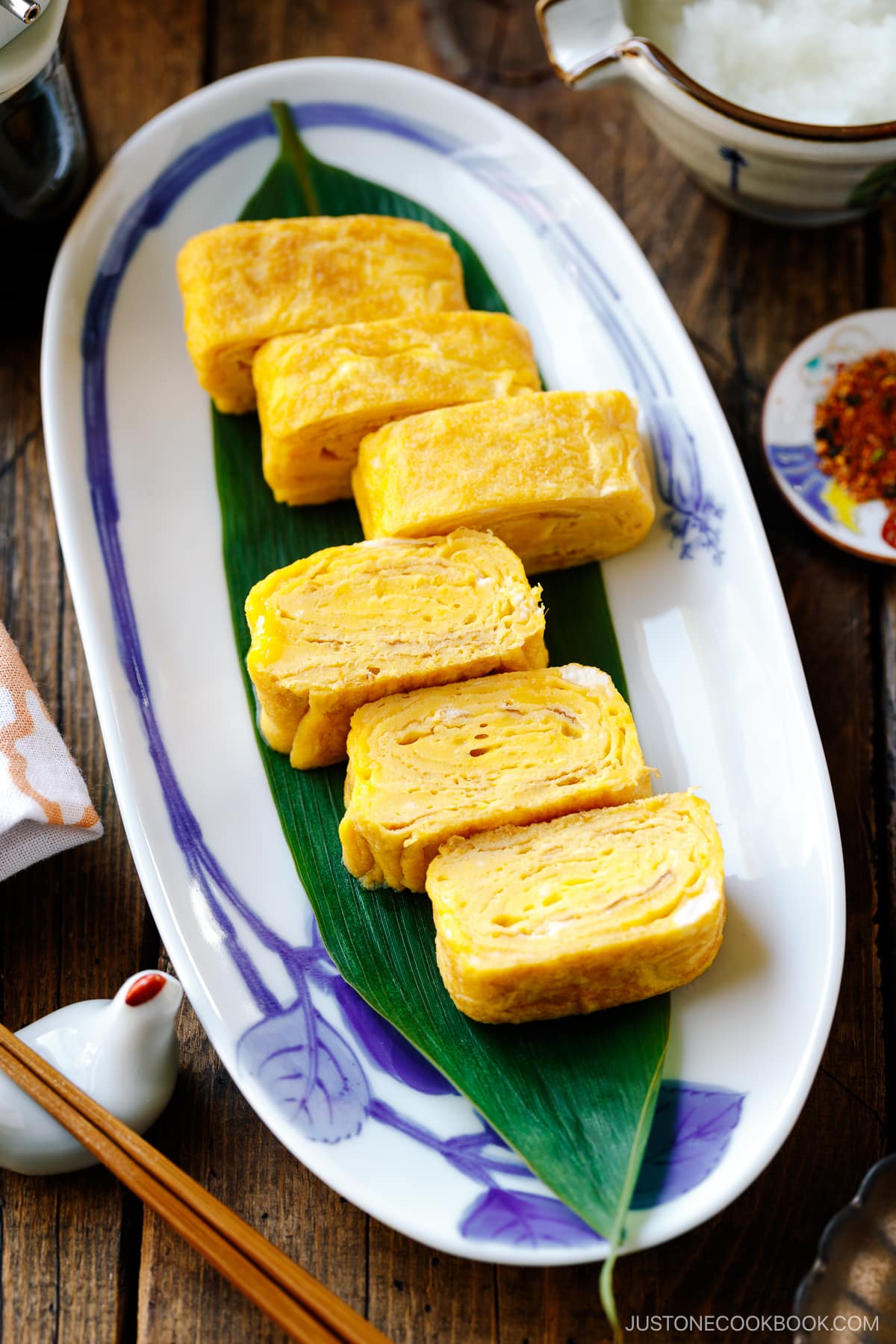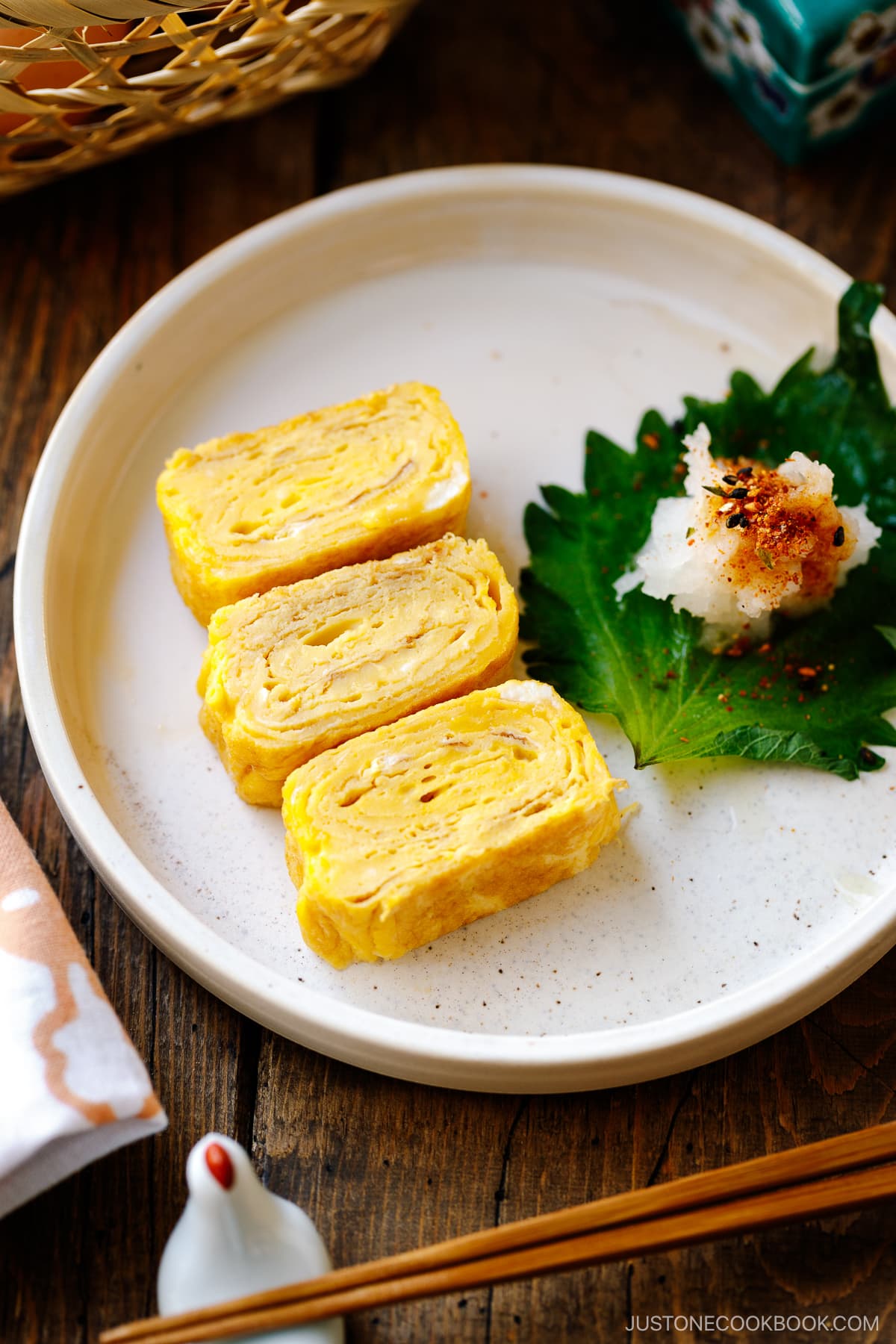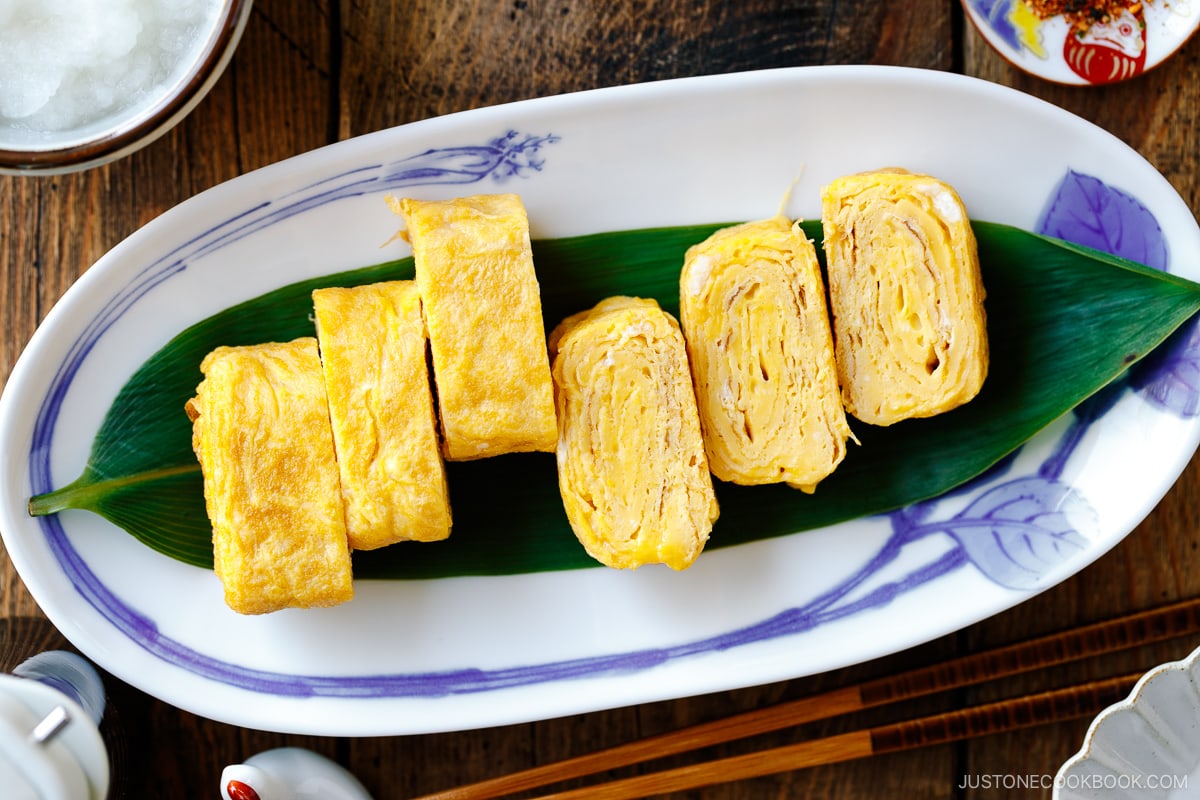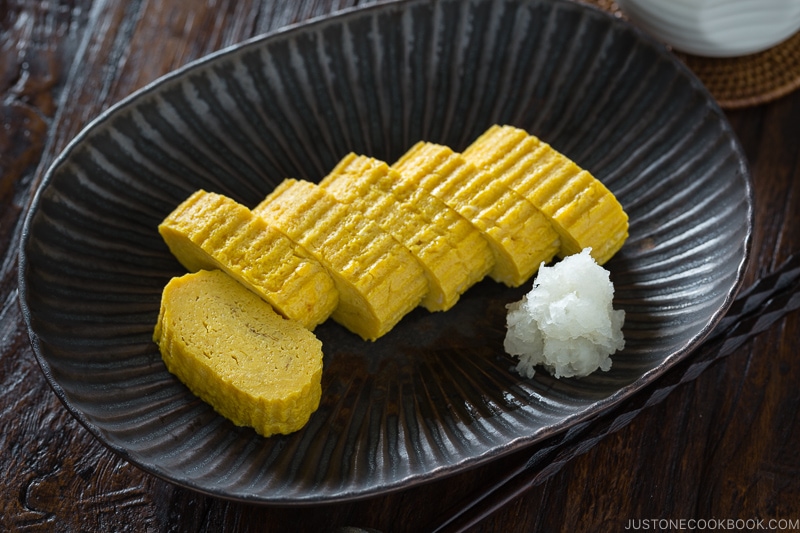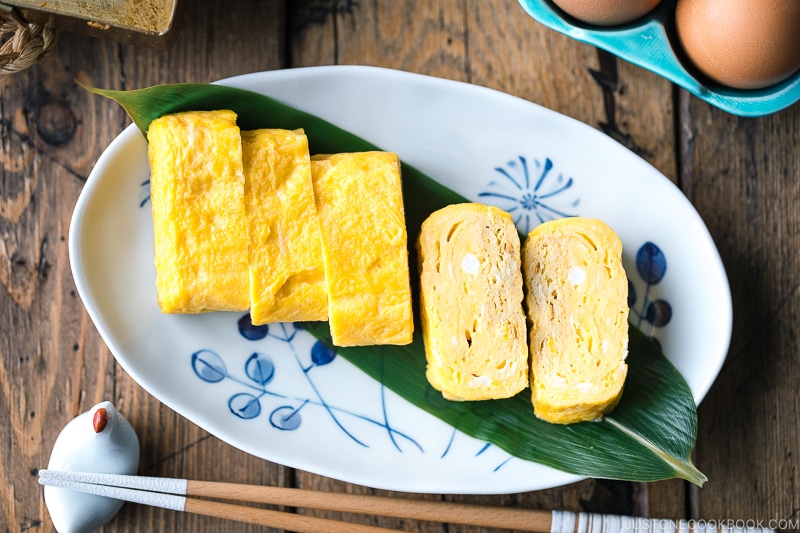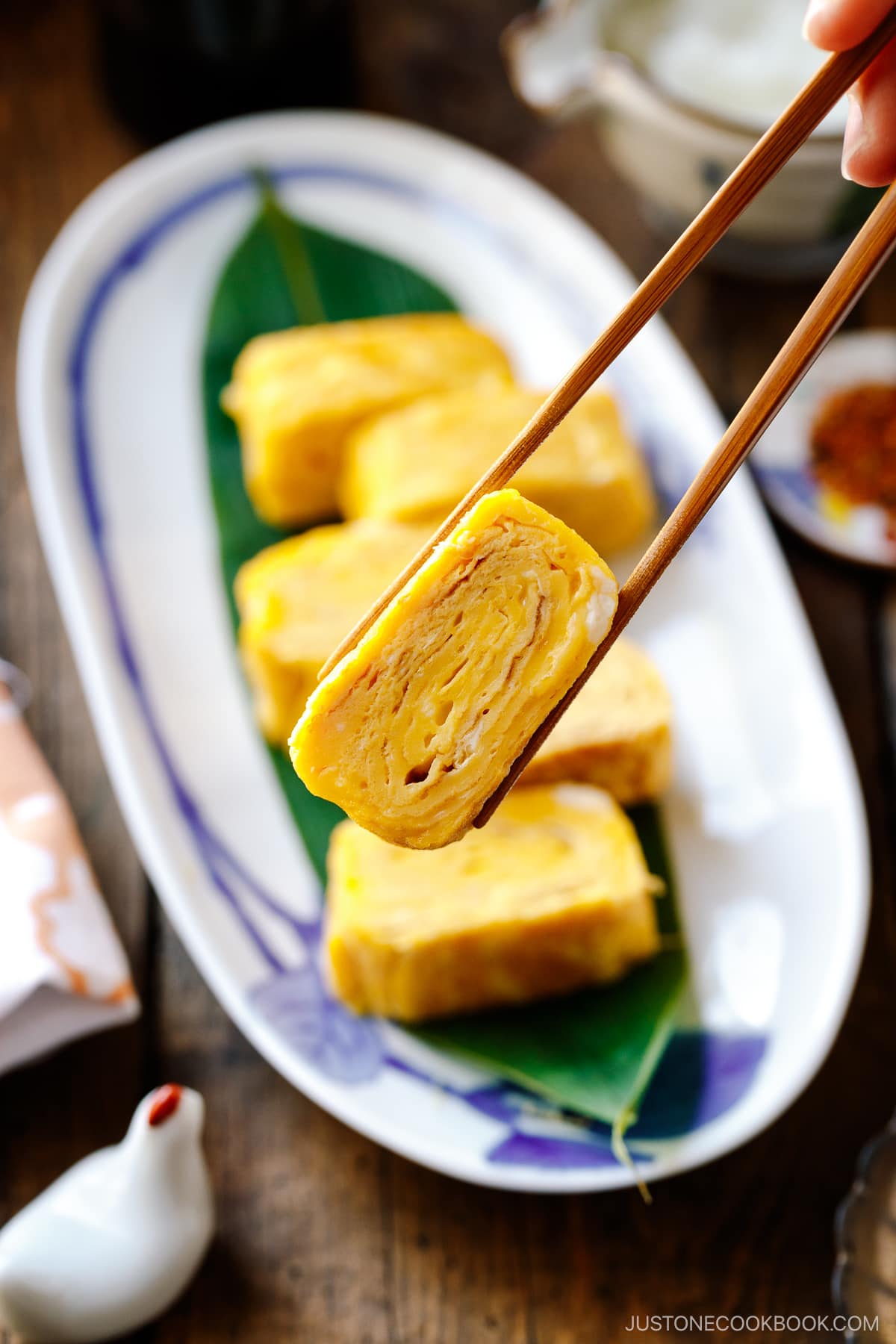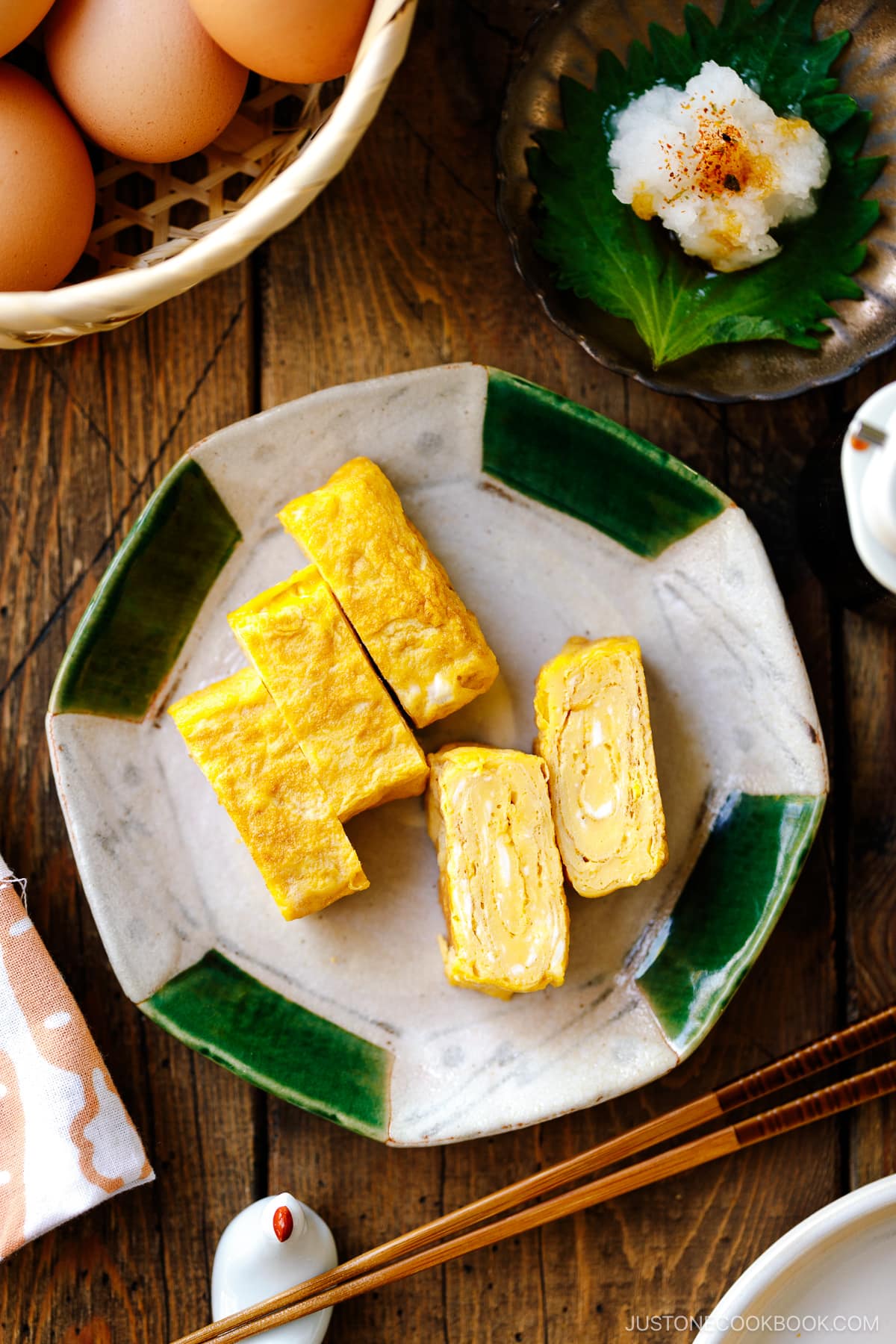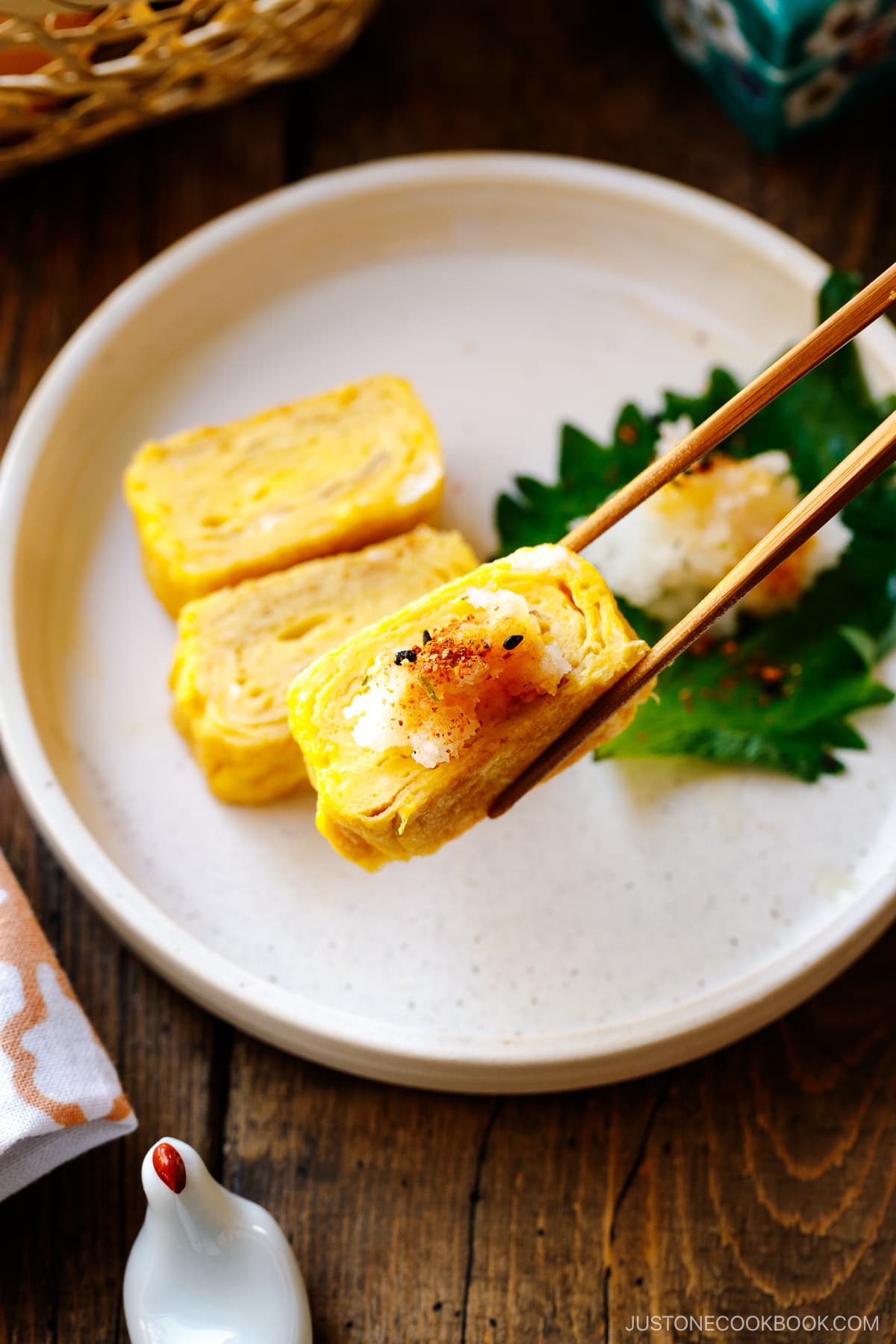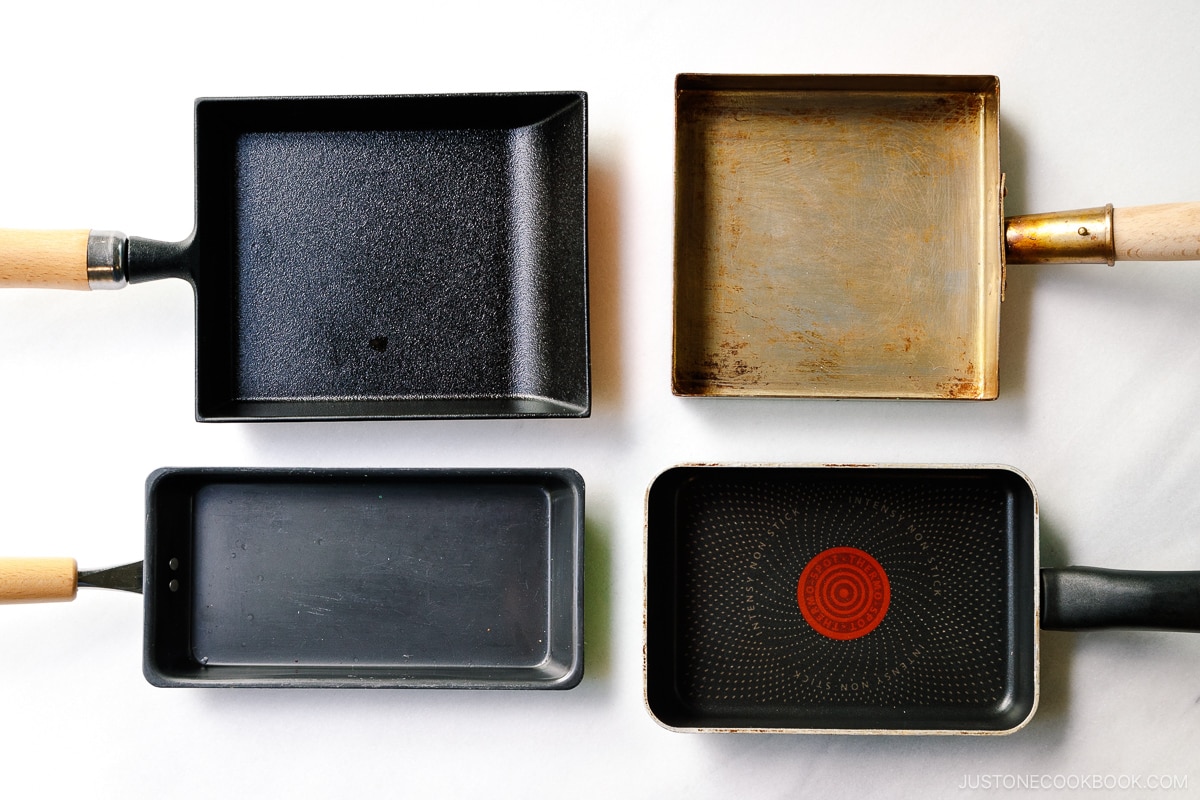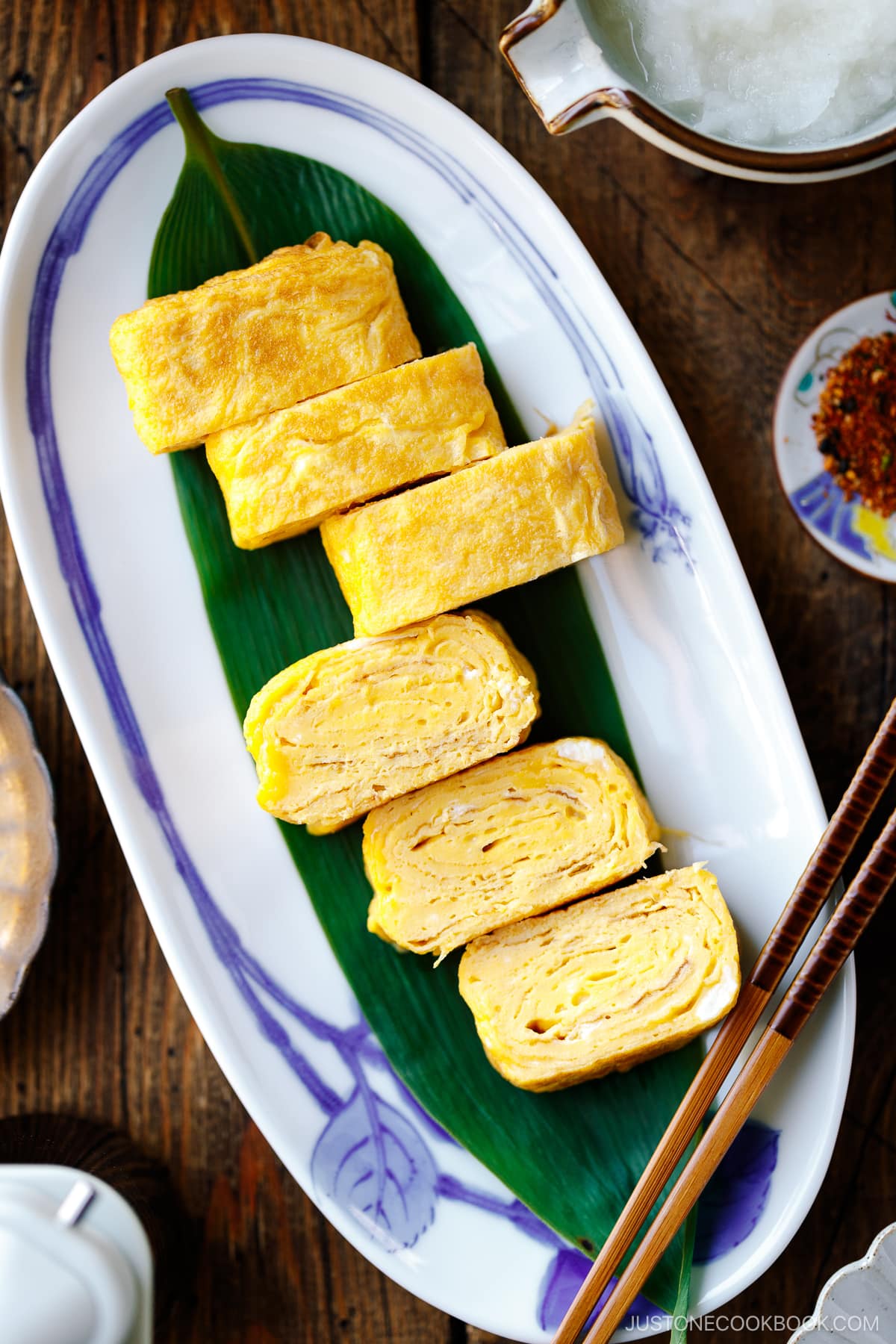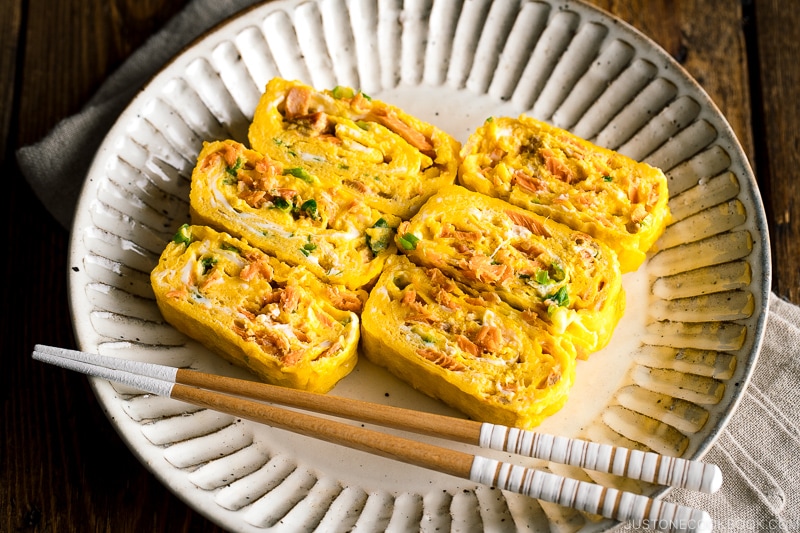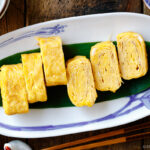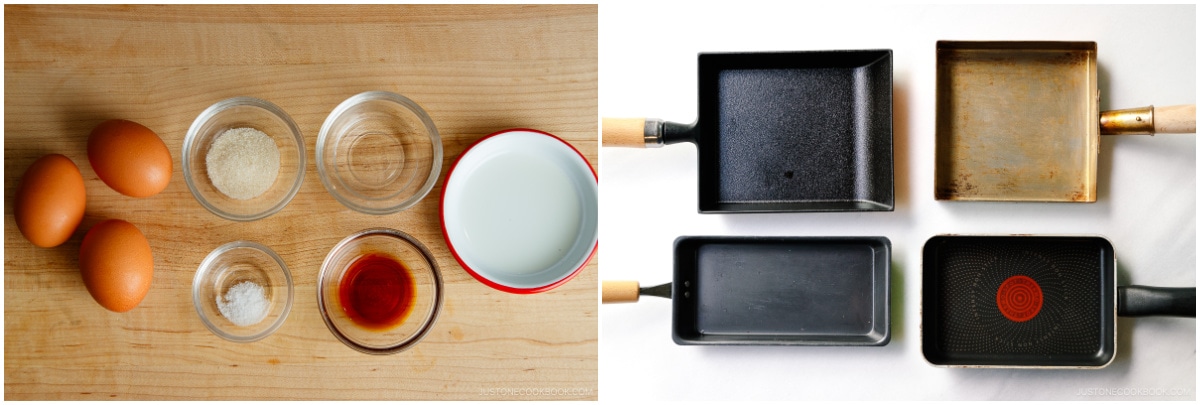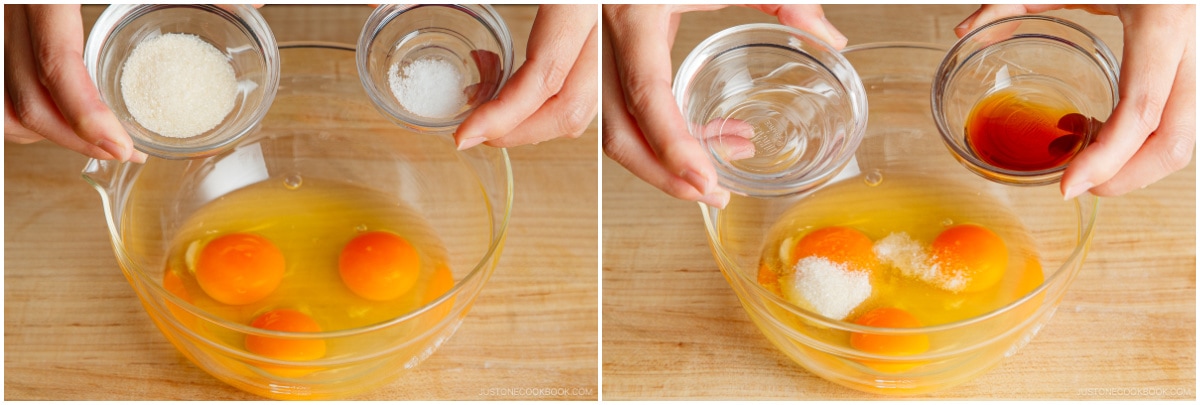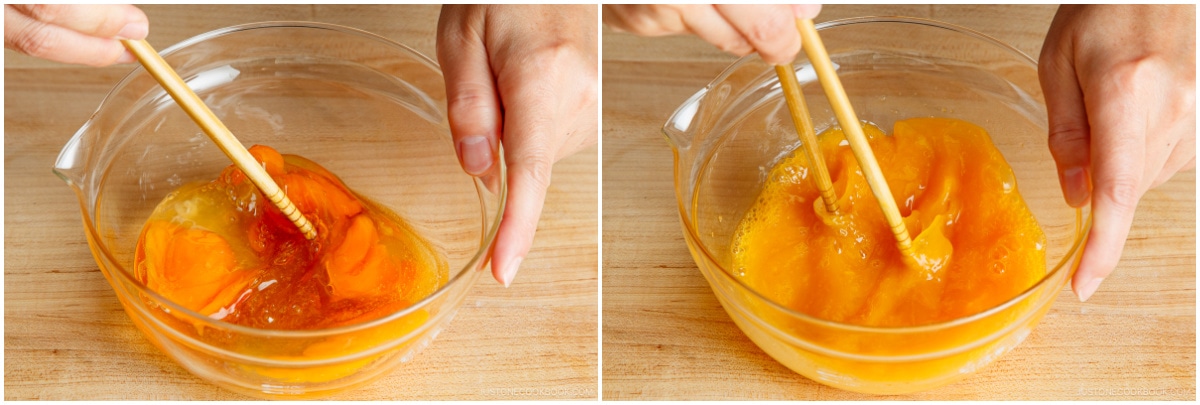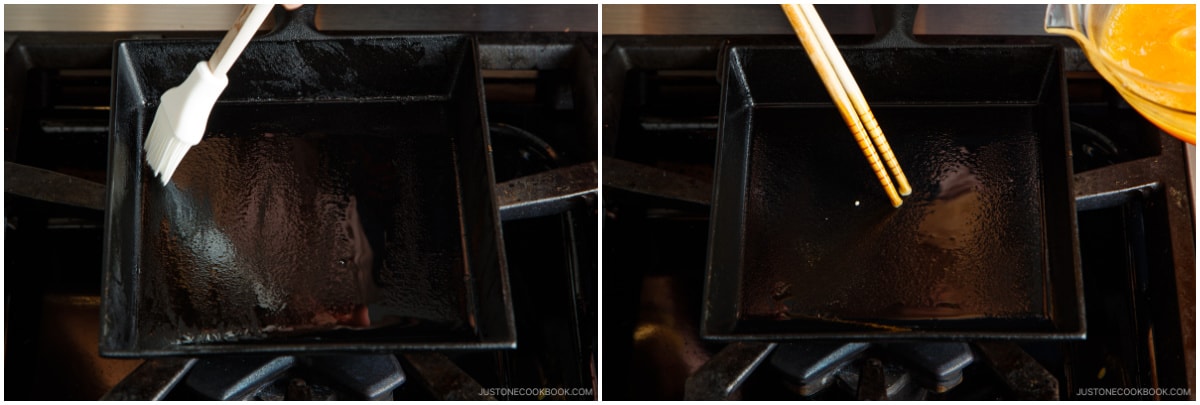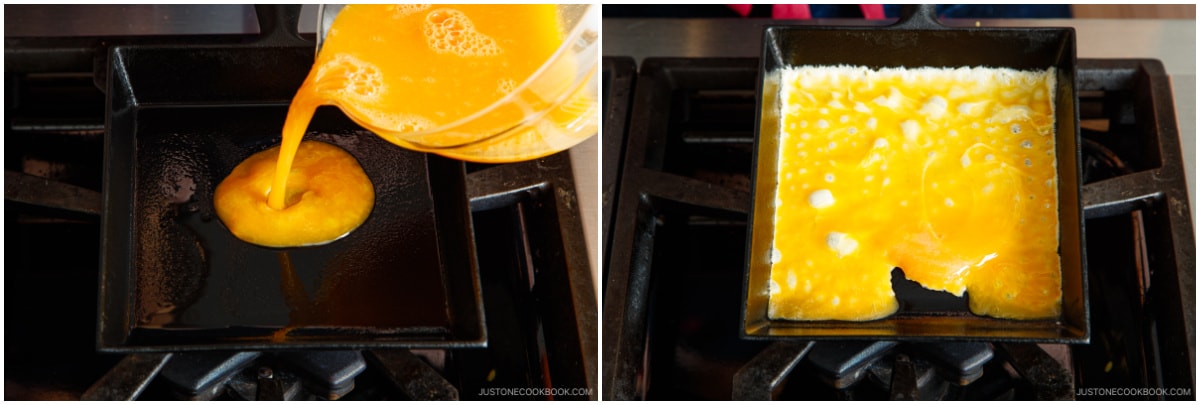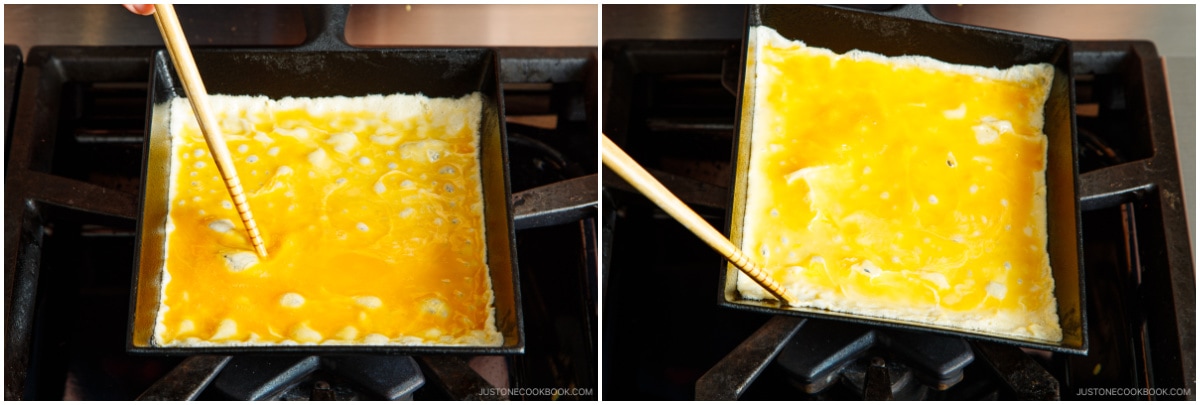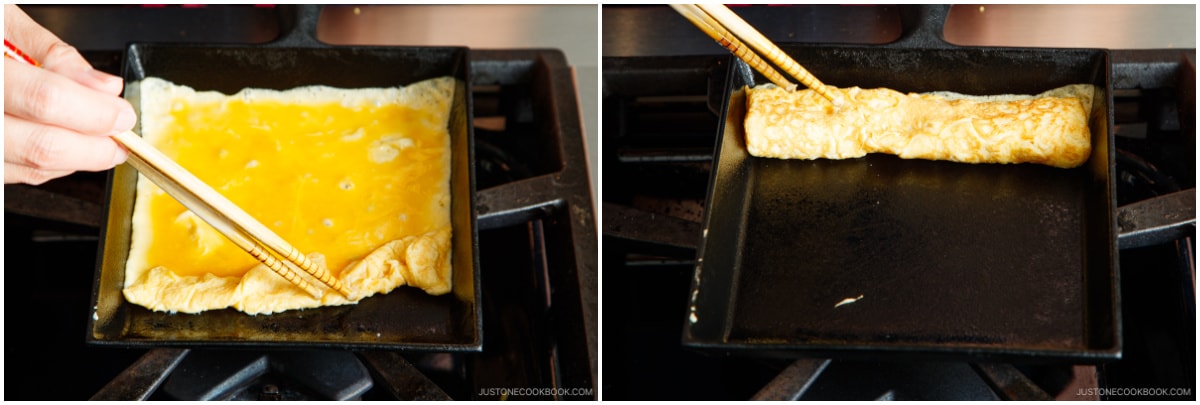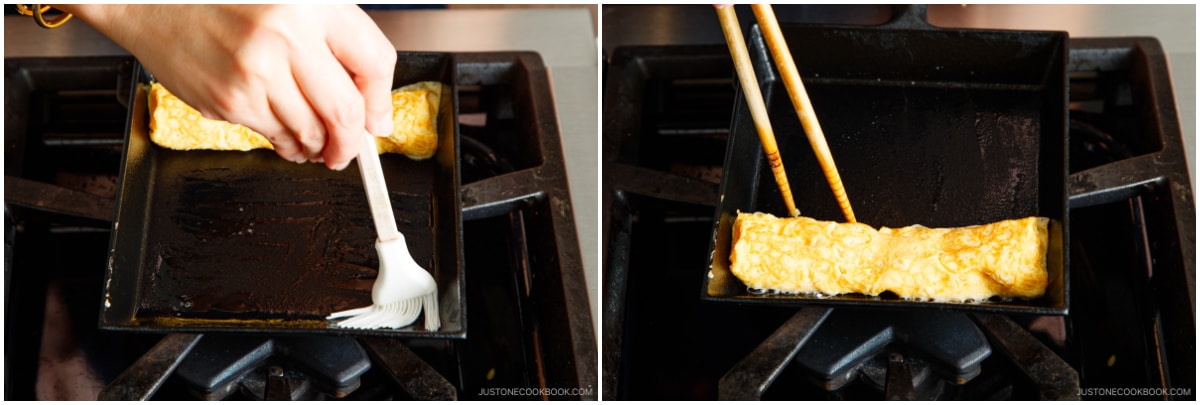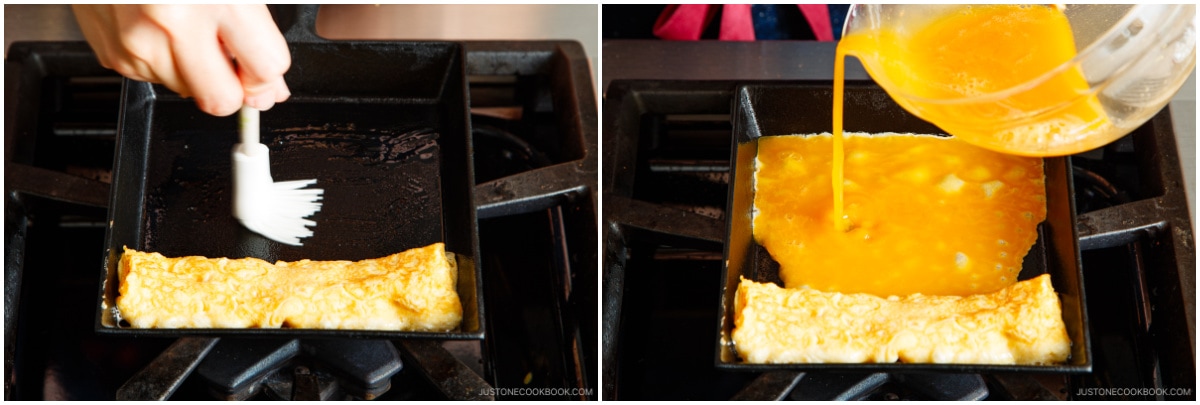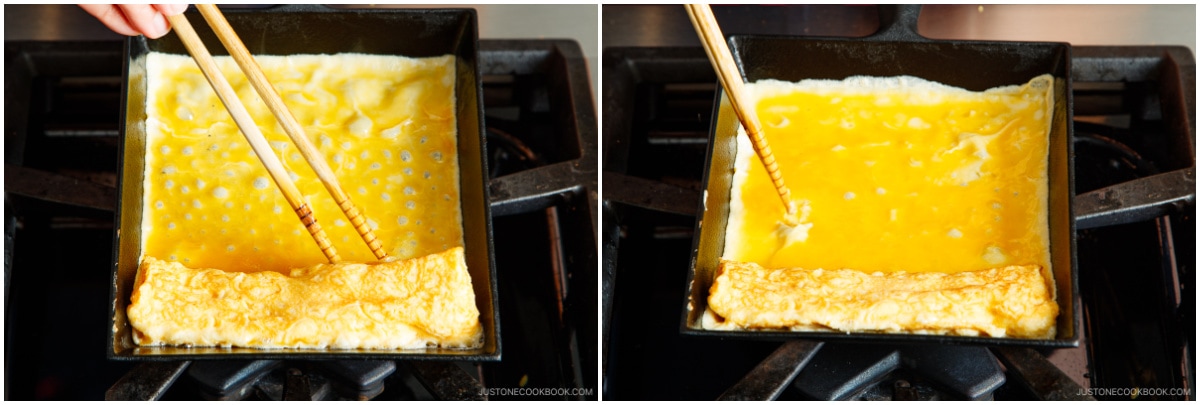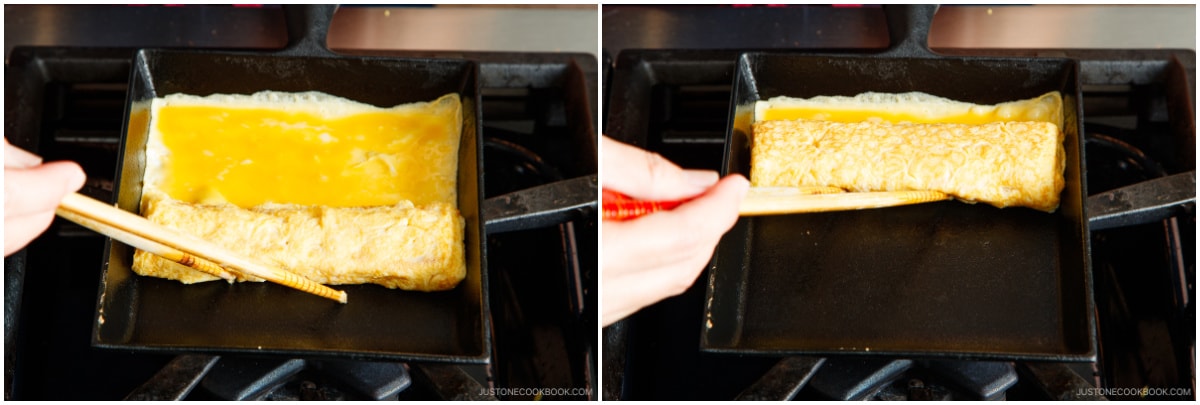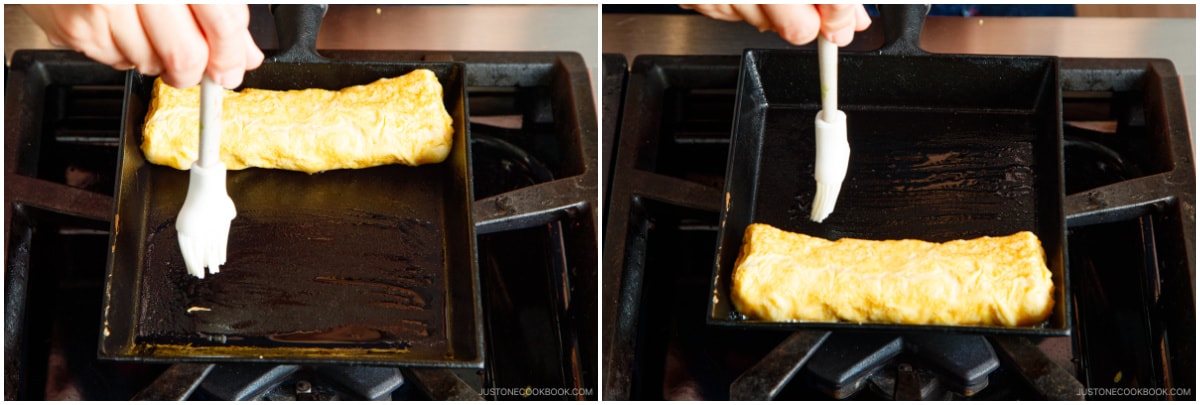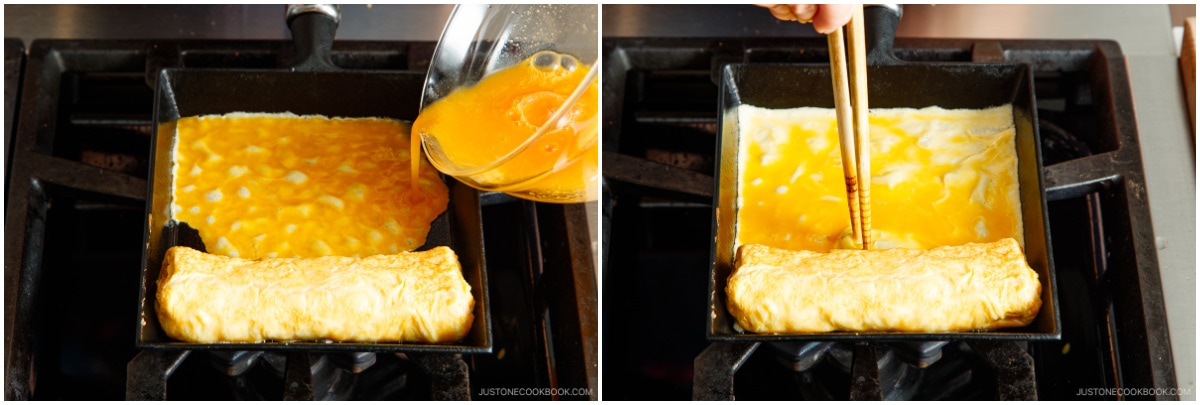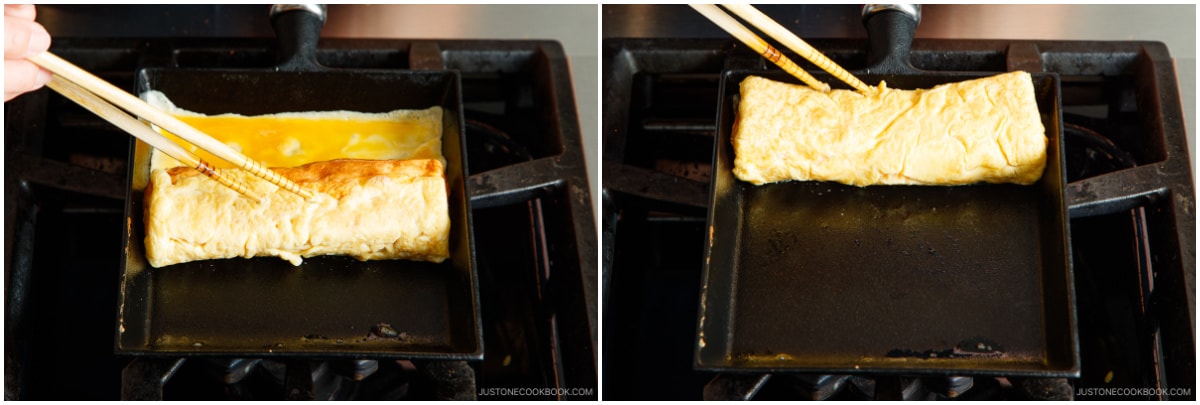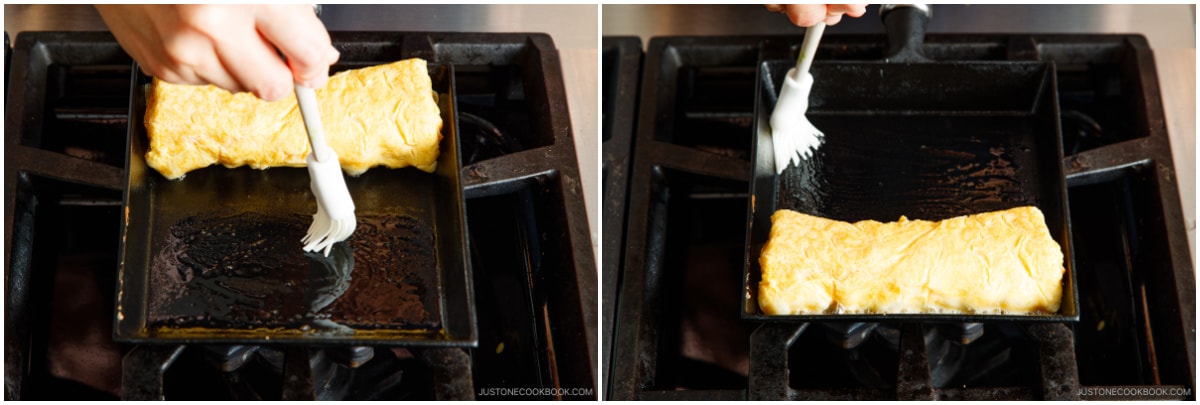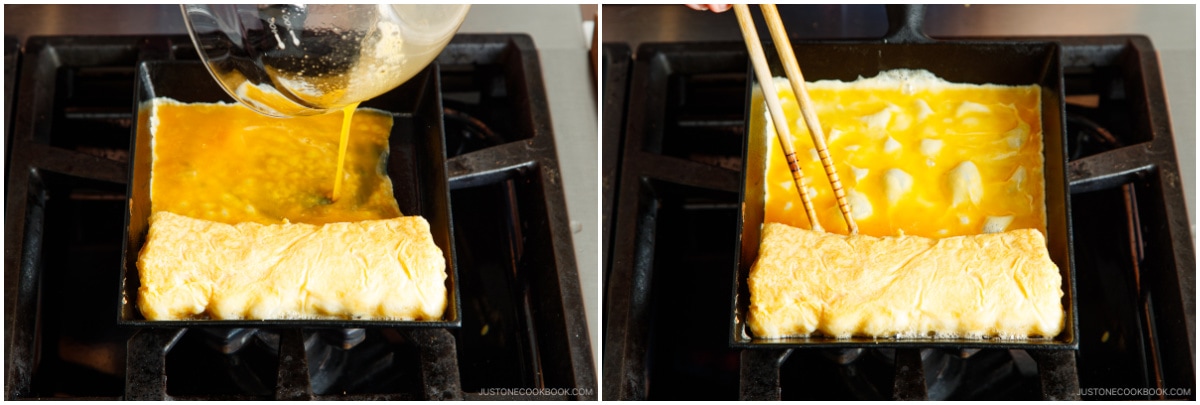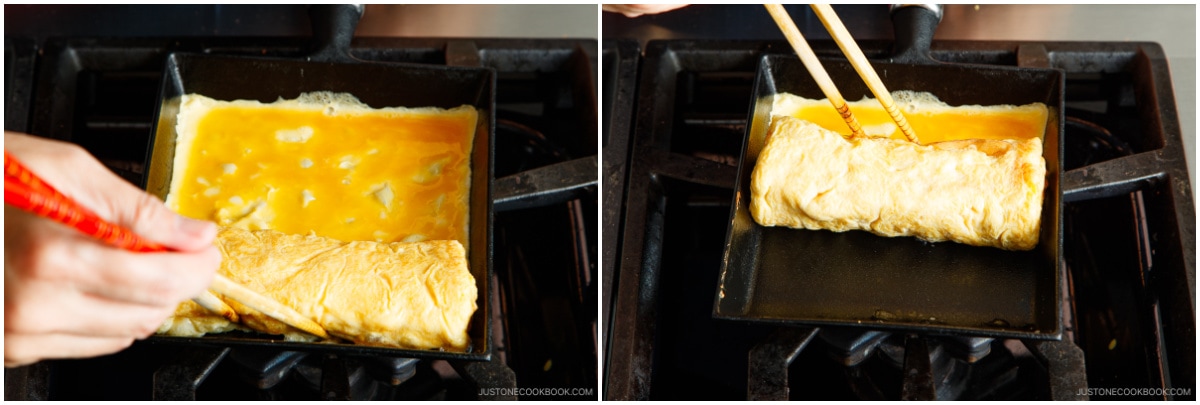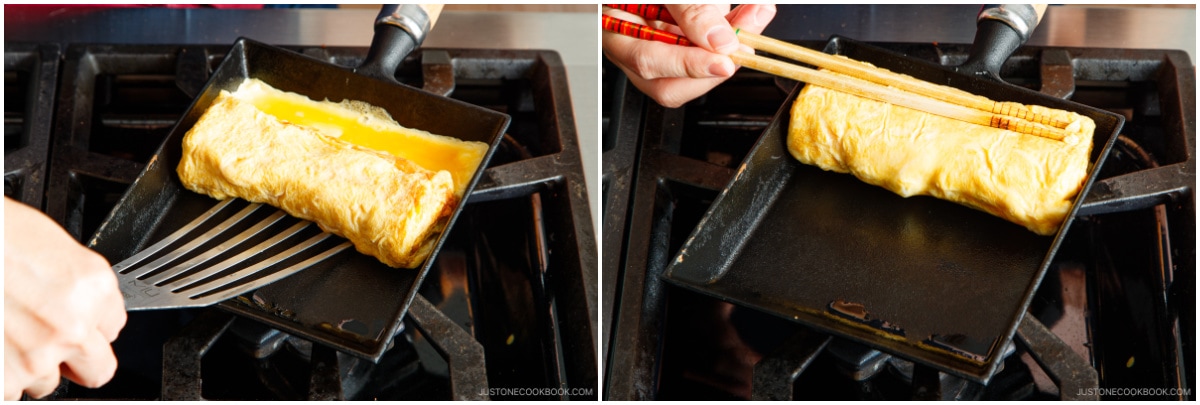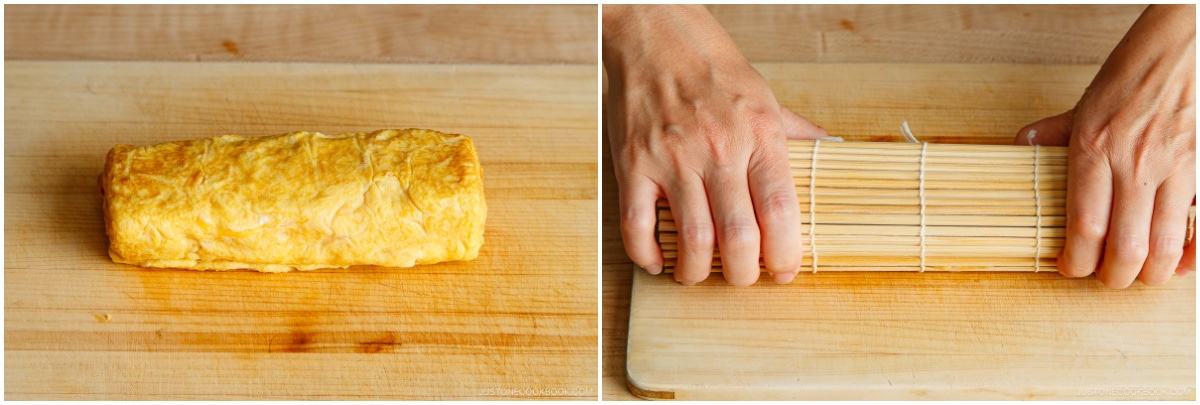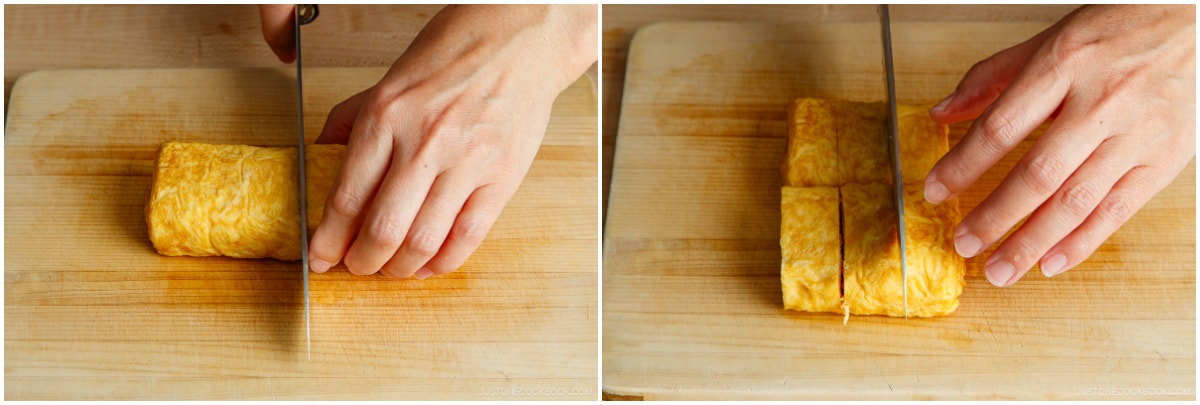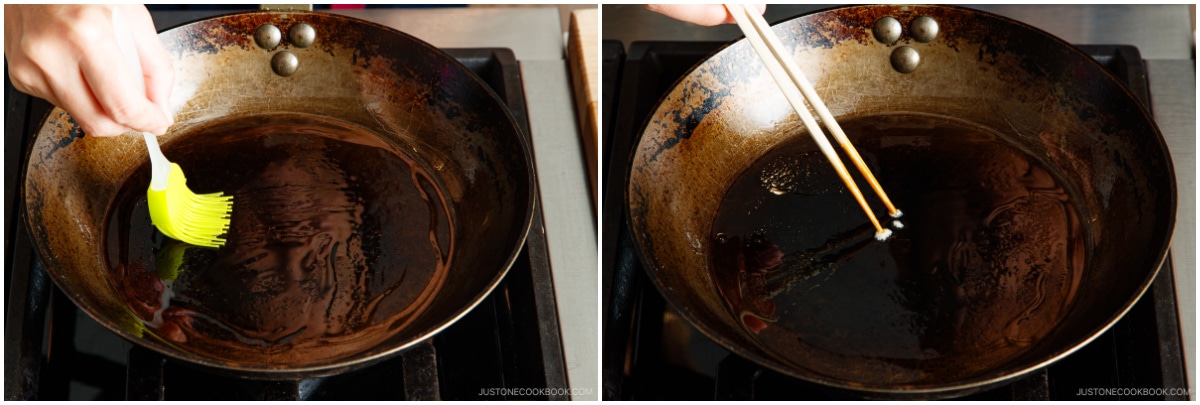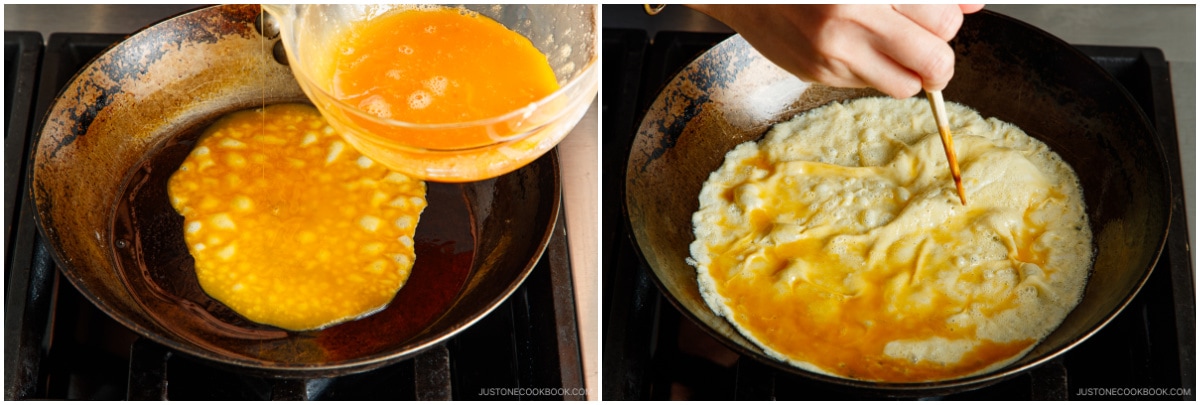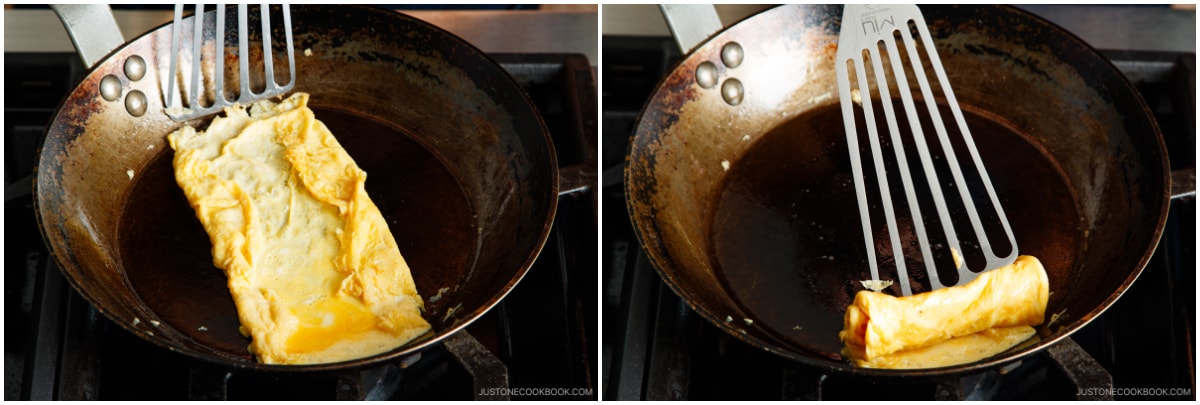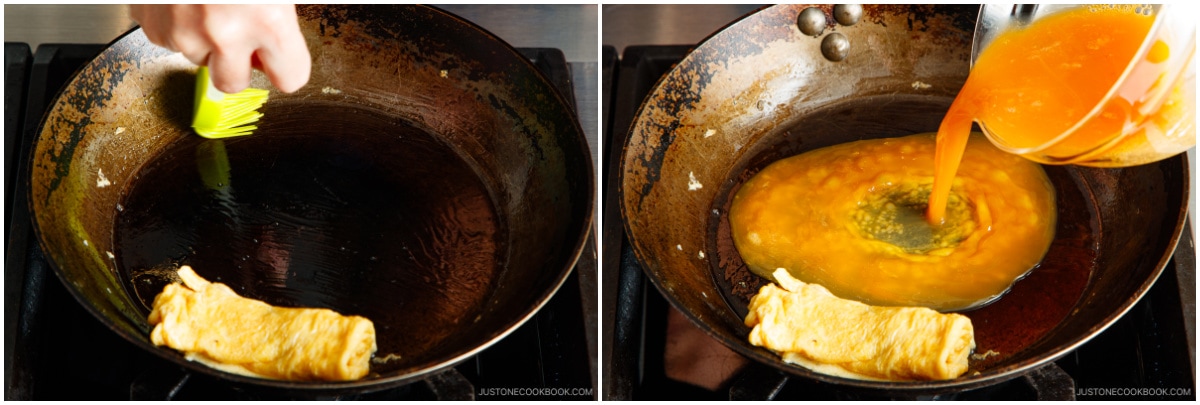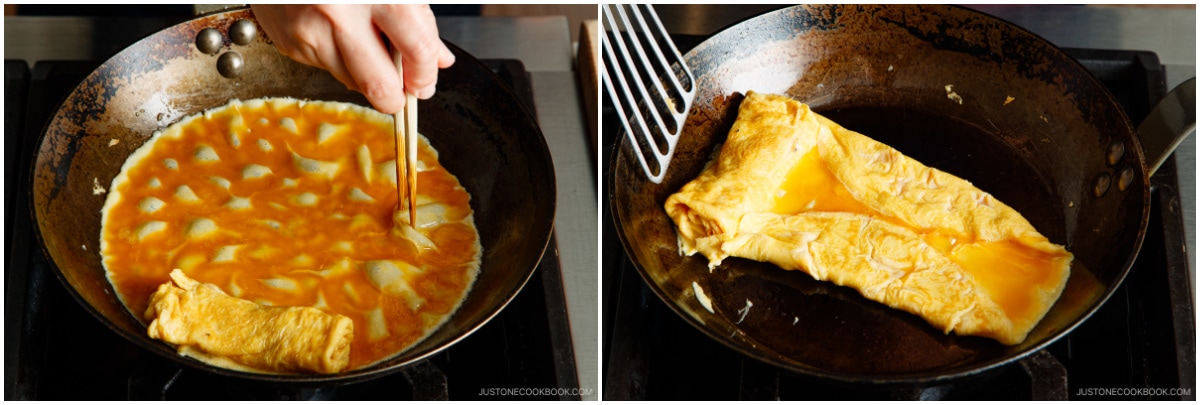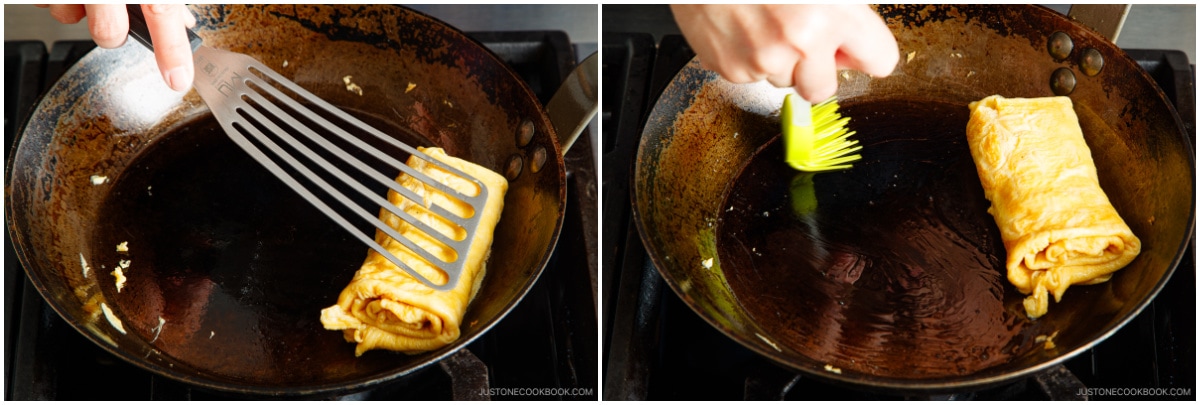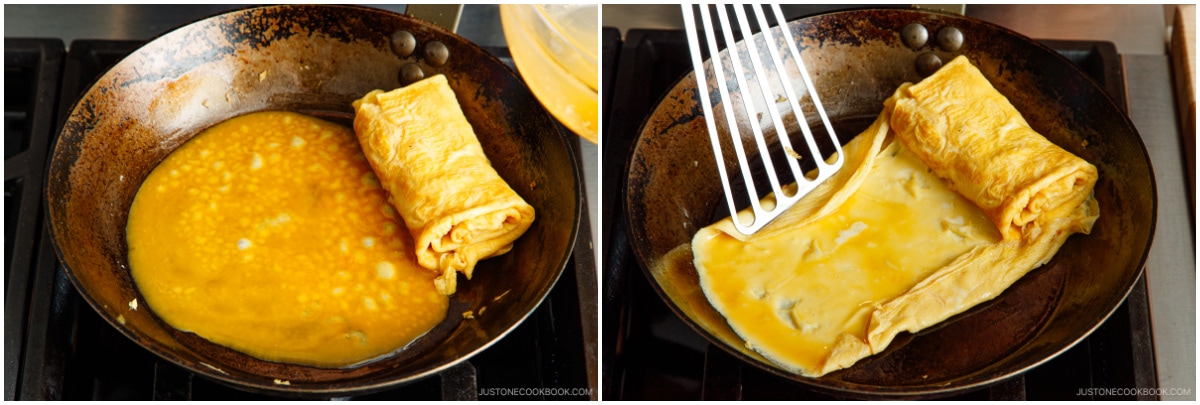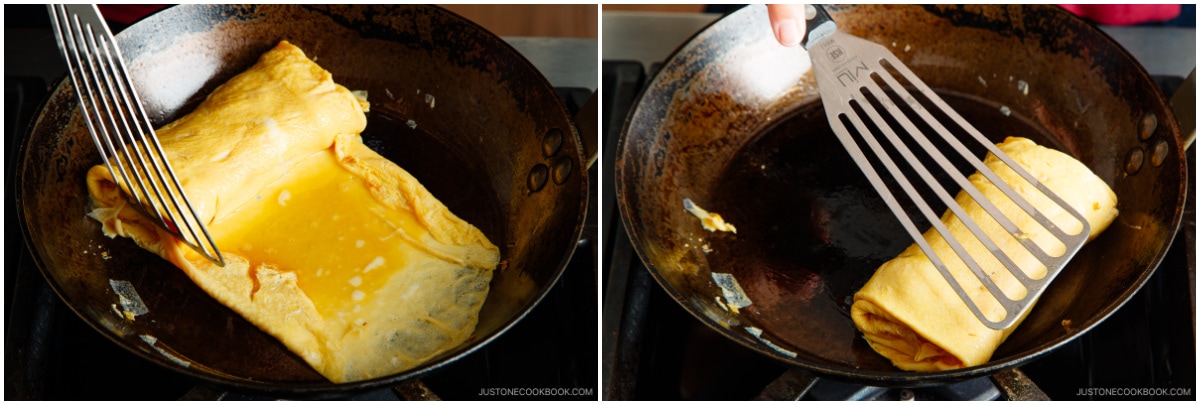I’ve shared a few methods for making tamagoyaki, the Japanese rolled omelette that serves as a powerful protein side dish for breakfast and bento lunches. Both my original recipe and this one, inspired by Midnight Diner, involve a bit more skill and require the use of dashi (Japanese soup stock) in the ingredients. To encourage everyone to make tamagoyaki more often, I’ve developed a technique without the use of dashi. Here, we have a simple, 3-Ingredient Tamagoyaki recipe that you can rely on! I hope it becomes a staple in your menu. Note: Before you jump straight to my recipe card, I encourage you to carefully read through the tips and techniques. It is a little lengthy, but the information will equip you with the know-how to give you a good head start in making the perfect tamagoyaki.
What is Tamagoyaki?
Tamagoyaki, the Japanese rolled omelette, is known for its bright yellow, miniature pillow-shaped appearance. This petite egg dish is ubiquitous in Japan and is a favored option for breakfast or as a filling for bento boxes. The preparation involves rolling thin layers of seasoned and slightly sweetened egg mixture to create a compact, rectangular shape.
Variations of Tamagoyaki
Tamagoyaki (玉子焼き, 卵焼き) is a general umbrella term for various types of Japanese rolled omelettes. It can be dashimaki or atsuyaki depending on the region.
Ingredients for Tamagoyaki
You’ll need only just 3 ingredients to make this tamagoyaki:
Eggs – I use American large eggs. Each weighs 50 grams without the shell. Sugar – I use organic cane sugar from Costco Soy sauce – Use usukuchi soy sauce or Japanese light-color soy sauce so your tamagoyaki doesn’t turn dark in color. If you don’t have it, use regular Japanese soy sauce. Please note that Japanese light-color soy sauce is different from Chinese light soy sauce. Kosher salt – Just a pinch to bring out flavors without adding more sugar or soy sauce. Water – This can be optional, but I believe it yields a fluffier omelette. Neutral cooking oil
As a variation, you can season the egg mixture with mentsuyu (noodle soup base) instead of soy sauce.
How to Make Tamagoyaki
I won’t claim that making tamagoyaki is easy; in fact, it requires practice. I lose the hang of it when I don’t make tamagoyaki for a while. I was a bit out of practice in the video, as you may have noticed. This reminds me that I need to continue making tamagoyaki occasionally!
Cooking Tips and Techniques
For a successful result, please read and remember the following key points before cooking:
Do not whip the eggs and avoid incorporating air into the mixture. The best approach is to “cut” the egg with chopsticks in a zig-zag motion while the chopsticks are touching the bottom of the mixing bowl. Optionally, for a refined texture and even coloring, you can use a fine-mesh sieve to pass the egg mixture twice.
Heat the pan thoroughly. Wait until the pan is well-heated before pouring the egg mixture. Test the heat by the sizzling sound; you can use water or dip your chopsticks in the egg mixture and touch the pan.
Grease the pan well each time before you pour the egg mixture. I understand you want to use less oil, and I do, too! However, if you skip and skimp, the egg mixture will stick. If using a non-stick pan, you may use less oil. Listen for the sizzling sound each time you add the egg mixture. This confirms that the pan is hot.
Adjust heat depending on your skill level: Beginners, use medium heat; as you become proficient, use medium-high or high heat for a finely textured tamagoyaki. Adjust heat by moving the pan closer or farther from the heat source.
Tilt the pan to evenly distribute the egg mixture and start rolling as soon as it is set and not runny. Once a thin layer of the egg mixture is in the pan, cook the egg quickly before turning too brown or burnt. If one area has a pool of the runny egg mixture, tilt the pan and distribute it so that it will cook faster.
Pop the air bubbles to avoid uneven layers and breakage while rolling. Once you break the air bubbles, fill it with a runny egg mixture.
Do not worry about the initial rolls. The first few rolls form the center of the tamagoyaki, so even if the layers are not perfectly rolled up, do not worry!
Lift the finished rolled log and pour the egg mixture under the tamagoyaki to bind the new layer and finished layered log.
Shape the roll with a bamboo mat. This helps cook the egg with the remaining heat.
How to Enjoy Tamagoyaki
While tamagoyaki can be enjoyed on its own, it is often served with grated daikon. For added flavor, drizzle soy sauce and, if desired, sprinkle optional shichimi togarashi (Japanese 7 spice) before savoring.
How to Store and Reheat
The good thing about tamagoyaki is that it’s delicious at room temperature too! Therefore, you can make it ahead and pack in your bento lunch box. You can also freeze them, but the texture will change slightly (I don’t mind, but you might).
To Refrigerate: Cool and store in an airtight container for up to 3 days. Freezing: Cool and store in an airtight container for up to a month. To Reheat: Thaw in the refrigerator overnight. If you’re packing in a bento lunch box, you can pack it frozen without thawing (should be thawed by lunchtime).
Best Tamagoyaki Pan
Do we need a tamagoyaki pan? A special rectangular or square pan helps create a nice log shape, but you can still make a rolled omelette without one, and I’ve shared how to do it in my recipe below. If you’re curious about which tamagoyaki pan is the best, I’d say it depends on your skill and preference, but I’ll also share my own experience. If you are making tamagoyaki multiple times a day, a traditional copper tamagoyaki pan can produce a wonderful tamagoyaki with a nice custardy texture, thanks to its excellent heat conductivity. However, it wasn’t the right choice for me, as it requires a considerable amount of oil and a lot of practice. I initially loved using the T-fal non-stick tamagoyaki pan; it was very user-friendly. However, I discontinued its use when I decided to phase out non-stick frying pans altogether. I experimented with a small carbon steel tamagoyaki pan, but the eggs tended to stick more than I preferred. After trying out various tamagoyaki pans, I decided to invest in another pan—a cast iron tamagoyaki pan by Iwachu, a well-known 120-year-old Nambu ironware (南部鉄器) manufacturer from Japan. I had concerns about its weight initially, but after using it for a while, I got the hang of it, and I’m happy to say I’ve finally found the one I like! Having a good tamagoyaki pan contributes to making a nicely shaped omelette, but I can’t stress enough that practice is the most crucial factor of all. Even with a great tool, if you don’t practice well, you may still struggle to make a good omelette. Although it’s heavier, and I can’t rely on centrifugal force to help roll the omelette, I appreciate that it’s almost non-stick. Here are some of the tamagoyaki pans I’ve used in the past.
Non-stick tamagoyaki pan Copper tamagoyaki pan Carbon steel tamagoyaki pan Cast iron tamagoyaki pan
Fun Fillings for Tamagoyaki
Homemade tamagoyaki sometimes includes a wide variety of ingredients. For a little fun and variety, consider whisking in the following ingredients to the egg mixture:
Julienned shiso Chopped green onions Minced vegetables Red pickled ginger (kizami shoga) Corn Shirasu (small white fish)
You can also sprinkle a following ingredient before rolling each layer of egg mixture:
Shredded cheese Mentaiko Ham/bacon Imitation crab Blanched spinach Salmon Flakes (see the picture above) Soboro chicken Nori seaweed (cut in half)
What to Serve with Tamagoyaki
Tamagoyaki is a nutritious and protein-packed side dish that complements any Japanese or Asian-style meal. We enjoy serving it as part of the ichiju sansai-style meal.
Main: Japanese Salted Salmon, Miso Cod, Tsukune (Japanese Chicken Meatball Skewers) Side: Hijiki Salad, Kinipira Gobo, Japanese Cucumber Salad (Sunomono) Rice: Onigiri (Rice Balls), Ochazuke Soup: Japanese Egg Drop Soup (Kakitamajiru)
Wish to learn more about Japanese cooking? Sign up for our free newsletter to receive cooking tips & recipe updates! And stay in touch with me on Facebook, Pinterest, YouTube, and Instagram.
